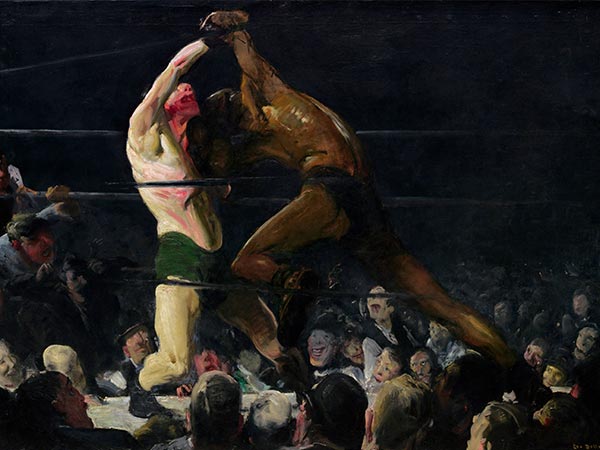Subtotal: $
Checkout
A Member of This Club
An after-school program for at-risk youth teaches self-respect, restraint, and responsibility – through boxing.
By Springs Toledo
February 24, 2022
He knew not to come in. I was working the mitts with another student in the boxing gym I’d set up in the high school basement, and he was standing outside the door. A third student skipping rope nearby saw him too.
“C’mon, Mr. T,” he said. “Don’t do me like this. I didn’t hit him.”
“That’s why you’re out two months instead of forever.”
His name was Serious Wilson. He was a sixteen-year-old Jamaican immigrant, a new transfer that year made to feel unwelcome by a group of varsity hockey players. It was getting worse. One of them threw a pencil at him in physics class and he lost his cool; he stood up and tipped the desk over with a crash, then stormed out. The vice principal consulted me about consequences. He wanted to abbreviate them because he suspected that racism was involved.
“Give him the max,” I said.
I knew he could do a two-day suspension standing on his head. But two months of no boxing? That gave him real reason for regret. Wilson was the most avid member of an after-school boxing club I had set up for at-risk students.
The idea came out of an IEP (Individualized Education Program) team meeting with a sophomore who was failing all his classes and wouldn’t talk about why with anyone. He sat in the meeting with his head down. I knew why. Earlier that day, his peers told me that he was being terrorized in the halls. They said he ran home every day to avoid the gauntlet.
“What if I taught you how to box after school?” I said, breaking the heavy silence. His head shot up. “It’s a rare skill set to have. Though I have to be paid.”
—In grades. Three days a week, I would get a report from his teachers. Was he doing his classwork? His homework? If so, he would earn lessons in the Sweet Science at 3 p.m. He never missed one.
Someone, somewhere, sprinkled stardust on the endeavor. It sparkled when I noticed that his tormentors were passing by the basement gym every day at 3:30. The door was closed, so they had no idea what was being built inside. Their victim was learning how to slip rights and weave under left hooks, and realizing with great surprise that he didn’t have to accept punishment or run away. Gradually, he mastered a series of combinations. I held the mitts up and watched his eyes come alive as the force of his punches began resounding like cracks from a whip. That was when I opened the gym door. He didn’t see his tormentors passing by, but I did. They stopped and gawked, and I could almost hear them gulp. They never went near him again.

George Bellows, Both Members of This Club (Public domain)
The Sweet Science gave him a reason to hold up his head. It did what no school psychologist or social worker had done, and it did so in record time. No one was throwing shots at him in the hall anymore – except for me. Whenever we crossed paths, I’d greet him with a right cross or a left hook that he’d automatically slip or weave under without breaking stride. It was an artful way to let everyone know what had changed. And much had changed. Violence was no longer a terror to him; no longer a roaring maelstrom threatening to humiliate and consume him. It was captured, tamed, and reduced. It fit into his pocket.
“Do you remember when you were afraid of getting hurt?” I said when he left for summer break. “Well, you should still be afraid – of hurting others. So don’t, unless you absolutely have no choice.”
That was the first principle of what became The Sweet Science Club. It was geared toward students with low self-esteem and anger-management issues – outreach for the hard-to-reach. Members resolutely paid their weekly dues (passing grades and good behavior) despite the fact that the focus was on technique and the only sparring was with me, and only after they advanced to level 3, which took months. The club was a testimony to the age-old allure of boxing, an allure easily seen in the graceful execution of a rare skill set and the rat-a-tat-tat of a speed bag. It’s in the rules that temper the sport’s capacity for mayhem and anchor it to age-old norms of chivalry. It’s in an esoteric history and the larger-than-life characters that populate that history.
Club members earned a moniker as a rite of initiation. Wilson was dubbed “Serious” because of his proud demeanor and because he had blossomed into a true devotee of the sport. “Demolition” Brown spoke softly and carried a big punch. “Demon” Molina was a former gang member from El Salvador who developed a frenetic, swarming style. “Cool Jets” was a rarity: an honors student from the middle class with a storm inside of him.
Bonds were formed. Conversations explored coming-of-age topics. The Sweet Science was the spirit in the room – thunderous and rhythmic, demanding and inspiring. It spoke of rules and respect with the kind of authority that fatherless boys need most of all.
“What if somebody calls me n----r?” Serious Wilson asked one day. “Can I hit him?”
It’d be understandable, the spirit of boxing conceded, but would it be worth it? Would it justify putting that somebody in a coma and you in jail or civil court getting sued for medical expenses? This is the Sweet Science, the Manly Art. Don’t let their ignorance reduce you to a brute.
“What if somebody poses a physical threat?”
Role plays answered that question. I’d walk toward them with a bad look on my face and they practiced taking a step back with an arm extended. Marvelous Marvin Hagler gave them a script. Between fights, Hagler would treat himself to a beer in bars in and around Boston, and when tough guys approached looking for a reputation, he’d step back with open hands and say, “Please. Don’t try.”
If Hagler, a king, spared civilians from bodily harm, then why wouldn’t you? And if you’re going to give a demonstration of a rare skill set, a skill set you’ve devoted hundreds of hours to, then people should have to pay to see it. They should buy a ticket.
“That’d mean they’d have to buy a ticket to their own butt-whooping!” one of them said.
Exactly. But the gist isn’t a joke. It’s a way out of danger that looks nothing at all like cowardice.
“Then when can we use what we know?”
Three conditions must be satisfied. First, the threat has to be imminent, that is, right in front of you. Second, the threat needs to be capable, in other words, not some undersized loudmouth or a sixth-grader. Third, there can be no egress – no exit out of the situation. We back away like Marvin Hagler, like a king unwilling to hurt civilians.
“You have to see this,” the vice principal said with an ominous tone. I followed him to his office where he ran a security tape of an incident that had happened before school that morning. I saw the grainy image of a mid-year transfer student from Jamaica in the main hall, surrounded by the very hockey players who had been giving Serious Wilson a hard time. Wilson walked into the silent frame. He was trying to intervene, as a peacemaker. His hands were opened like Hagler’s, to show that he was not posing a threat. Then one of the hockey players broke away and started moving aggressively toward him – an imminent, capable threat. Wilson did what we’d practiced: he backed away, lead arm extended. He kept backing away until he bumped into the wall behind him – no egress. The hockey player kept coming.
“Uh-oh,” I said.
The vice principal held up his hand. “Wait. Watch this.”
A punch flashed out. Wilson slipped it as he had been taught, but instead of countering it with a fist, he reached out with an open hand for the hockey player’s elbow, and spun off. Instead of harming a civilian, he created an egress, a way out. It’s a sophisticated move, and he’d just learned how to do it a few days earlier. That open hand demonstrated his commitment to mastering technique. But more than that, it demonstrated a commitment to social values still new and strange to him.
I broke into applause.
But it wasn’t over yet. As the hockey player collected himself, one of his larger friends attacked Wilson from his blind side. Wilson had no choice; he hit his attacker with a right and down he went. I saw Wilson moving away when a third grabbed him by the legs and began to lift him up. Wilson’s back was to a railing – behind it was a twenty-foot drop. I took a deep breath, half-expecting to see his broken form on the floor below, just steps away from the door of the basement gym. Instead, he shook himself loose, took a half-step back, and threw a whistling uppercut to end the threat. I later heard that a front tooth went zinnnng!
I saw him after school. He was standing at the door of the gym, waiting for me to finish working the mitts with Demolition Brown. Demon Molina was skipping rope nearby.
“Mr. T, I didn’t want to hit them,” he said, without a trace of triumph in his eyes. “They’re civilians.”
“—And that’s why you deserve to be a member of this club,” I said. “Come in.”
Already a subscriber? Sign in
Try 3 months of unlimited access. Start your FREE TRIAL today. Cancel anytime.






